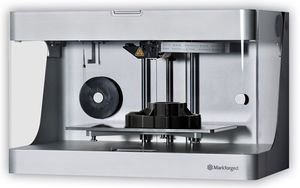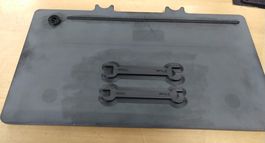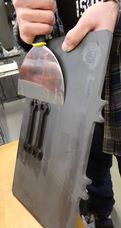Difference between revisions of "Markforged 3D Printer"
| Line 1: | Line 1: | ||
| + | {{#set: | ||
| + | |Is equipment=True | ||
| + | |Is located in facility=Prototype Lab | ||
| + | |Is used in domain=Electronics | ||
| + | |Has name={{PAGENAME}} | ||
| + | |Has icon=File:Mark 2 3D printer.png | ||
| + | |Has icondesc= | ||
| + | |Has iconwname= | ||
| + | |Has image=File:mark_two.jpg | ||
| + | |Has imagedesc=The Mark II machine by Markforged. | ||
| + | |Has description= | ||
| + | |Has certification= | ||
| + | |Has group=3D Printers | ||
| + | |Has make=Markforged | ||
| + | |Has model=Mark II | ||
| + | |Has ace=Ben Kraske;bkraske16@georgefox.edu | ||
| + | }} | ||
| + | [[{{#show: {{FULLPAGENAME}}|?Has icon|link=none}}|100px|left|top|{{#show: {{FULLPAGENAME}}|?Has icondesc}}]] | ||
| + | [[{{#show: {{FULLPAGENAME}}|?Has image|link=none}}|300px|thumb|upright=1.5|{{#show: {{FULLPAGENAME}}|?Has imagedesc}}]] | ||
| + | |||
Make: {{#show: {{PAGENAME}} |?Has make}} | Make: {{#show: {{PAGENAME}} |?Has make}} | ||
Revision as of 08:30, 15 July 2019
Make: Markforged
Model: Mark II
Ace: Spencer Monkewicz (smonkewicz22@georgefox.edu).
Location: Prototype Lab
Description
Insert Description Text
Here is an example of this piece of equipment being used.
Insert video media here.
Documentation
Terminology
Insert terminology here
User Manual
Training
Overview
Insert Text
Demonstration
Insert text
General Procedure
Insert text
Safety
Insert text
Certification
Foxtale Quiz
Troubleshooting
Maintenance
General maintenance
Insert text
Specific Maintenance Tasks
| Maintenance Procedure | Frequency | Done By |
|---|---|---|
| Sample | Sample | Sample |
The Mark Two is a desktop professional 3D printer capable of reinforcing parts with composite fiber, affording them durability and strength. It can print in a range of materials, including Nylon, Carbon Fiber, Fiberglass, and Kevlar.[1]
The current Ace of the Markforged 3D Printer is Spencer Monkewicz (smonkewicz22@georgefox.edu).
General Information
See this helpful video for more background information:
Prints on the Markforged must be started by a manager, as the software is account based.
Training
Background:
The Mark II is a FDM Printer. See the main page for more background on the FDM process. What sets the Mark II apart is its ability to inlay various materials in the print using a second nozzle. These materials include carbon fiber, fiberglass, and kevlar. These smaller materials are located on the second, smaller spool in the rear of the build space. The inlaying of these materials can be customized in Eiger (the printing software for the Markforged). The main materials for the printer are nylon and onyx, this material is contained in the dry box (black box behind the printer) in order to limit moisture contamination. Don't open this unless you need to change the material. Nylon is a typical plastic filament, which provides a clean finish and some flexibility. Onyx is nylon with chopped carbon fiber. This provides more strength and a little less flexibility.
Workflow:
Basic steps for usage are:
- Preparing Your File for Print
- Preparing the Printer
- Printing Your Part
- Removing Your Part
- Preparing the Mark II for the Next Print
Software:
The Mark II utilizes cloud-based print software Eiger. This means that the software can be accessed from any browser, but an account is required to do so. As such, prints will need to be started by management.
After login, the main screen returns to library. From this page, you can view and modify previous prints for reprinting or import a new STL for printing.
Once imported or selected, print material may be selected (Onyx in this case) reinforcement type may be selected and orientation may be edited in the pane on the right. Clicking a part face will orient that face to the build plate. Reinforcement and material settings may be edited with drop-down menus (These are generally best done in the internal view). Brims and support may be toggled on or off from the Part Settings drop-down menu. All these options are available from part view.
From internal view, density (number of layers of carbon fiber) may be viewed and edited using the slider at the bottom of the page (Blue is carbon fiber, White is main material).
Material costs and totals may be viewed in the upper left of the part screen. It's worth noting the dramatic change in cost with addition of Carbon Fiber inlay.
All Mark II prints should be okay-ed with Justin before being started. Once setup is completed and the printer is on, prints are sent to the printer via the "Print" option. Generally, select the option to start the print from the machine, rather than automatically.
Print Setup and Run:
The printer may be turned on with a switch on the rear of the machine. The machine will boot up and may need to update, let it complete this process. Before starting the print, glue needs to be applied to the build plate. Simply lift the build plate off the mount and apply the glue stick (found in the Markforged drawer/box) to the area where the print is located in the software (be sure to account for extra width due to the brim), the back of the plate where the machine will purge (print excess material which has been sitting in the lines and exposed to air), and the corner where the purge tower is located (see image). Place the place back on the mount. The Mark II is read to print.
Post-Processing and Reset:
Upon completion of the part, select clear bed on the touchscreen and remove the build plate from the mount. The purge line and tower should be easily removable by hand. For the part itself, take the putty knife found in the Markforged drawer/box and carefully remove the part. This may take quite a bit of force to accomplish. Make sure the blade of the putty knife and your hand will never come into contact if you slip (i.e.: brace the plate on the table and push the knife away from you along the plate). Work the knife along the perimeter of the part's attachment to the build plate and avoid prying with the knife when possible. After the part is removed, wash the plate with warm water only. When the plate is clean, dry it with a paper towel and place it back on the mounts.
Notes: The plate is ceramic, avoid dropping it. The plate will absorb oil, it is normal to see fingerprints, etc. on the plate.
References
Mentors Only
Advanced Maintenance Tasks for Aces only.
Changing Materials
Use the key located in __(ask managers or Justin)__ to unlock the dry box.
Follow Unload Plastic instructions to remove what is left of current primary material.
Follow Set Up and Load Plastic instructions to insert new primary material.
Follow Unload Fiber instructions to remove what is left of current inlay material.
Follow Set Up and Load Fiber instructions to insert new primary material.
Calibration and Setup
Follow Level the Print Bed instructions to level the print bed and set the correct nozzle heights.
Something about nozzle replacement and when?
Additional Calibration and Maintenance
See the Support Page for additional maintenance and operation guides.



